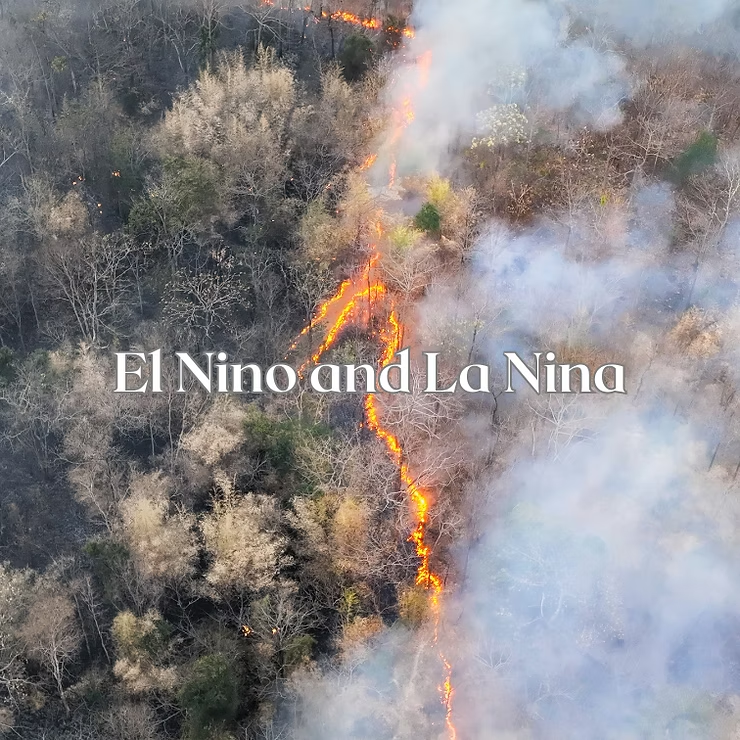Introduction
El Nino and La Nina are two powerful climate phenomena that influence weather, climate, and economies worldwide. Both are linked to sea surface temperature changes in the tropical Pacific Ocean and occur irregularly every few years. El Nino brings warmer ocean waters, while La Nina cools them. These shifts trigger ripple effects across continents, altering rainfall, storm activity, agriculture, and even global trade.
Key Takeaways
- El Nino warms Pacific sea surface temperatures, La Nina cools them.
- They occur every few years, lasting months to years.
- Both reshape global climate, from droughts to floods.
- Agriculture, fisheries, and economies are directly affected.
- Monitoring is vital for preparedness and risk reduction.
What is El Nino?
El Nino occurs when Pacific trade winds weaken, allowing warm water to spread eastward. This suppresses the upwelling of cooler, nutrient-rich waters and disrupts atmospheric circulation. The result can be heavy rainfall in some regions and drought in others, along with shifts in storm patterns and marine ecosystems.
- Weakened trade winds enable eastward movement of warm water.
- Rainfall increases in South America but droughts often strike Asia and Australia.
- Storm activity can intensify due to warmer waters.
What is La Nina?
La Nina is the reverse phase, with stronger trade winds that enhance upwelling and cool the central and eastern Pacific. This cooling drives opposite weather effects, including wetter conditions in Australia and Southeast Asia, drier weather in South America, and an active Atlantic hurricane season.
- Cooler Pacific waters reshape atmospheric circulation.
- Rainfall intensifies in Australia, Indonesia, and parts of Asia.
- Droughts emerge in South America and the southern United States.
Global Impacts of El Nino and La Nina
Weather and Climate
El Nino fuels warmer global temperatures and shifts rainfall, while La Nina often cools global averages. Both disrupt normal weather patterns, leading to extremes such as prolonged droughts, intense storms, and unexpected rainfall.
Agriculture and Fisheries
Crop yields often suffer during both events. El Nino can trigger droughts that dry out farmland, while La Nina may cause flooding that damages crops. Marine life also shifts as ocean currents and nutrient cycles change, disrupting fisheries and food supplies.
Ocean Currents and Hurricanes
Both phenomena reshape ocean circulation. El Nino weakens upwelling, reducing productivity in fisheries, while La Nina enhances it. Their influence extends to hurricanes—El Nino tends to suppress Atlantic storms, while La Nina fuels them.
Economic Consequences
These events affect multiple industries. Agriculture faces crop failures or floods, fishing industries see stock fluctuations, and insurance markets grapple with costly disasters. Tourism and energy sectors also experience disruptions, from storm damage to changes in heating and cooling demand.
Historical Examples
- 1997–1998 El Nino: Intense flooding in Peru and drought in Asia.
- 1982–1983 El Nino: Severe droughts in Indonesia and Australia.
- 2010–2012 La Nina: Boosted hurricane activity in the Atlantic.
Predictions and Research
Scientists use the El Nino-Southern Oscillation (ENSO) index, satellite data, and climate models to track and forecast these phenomena. While prediction accuracy has improved, uncertainties remain due to the complex interactions of atmosphere and ocean. Ongoing research seeks to refine models and assess the influence of climate change on the frequency and intensity of future events.
Conclusion
El Nino and La Nina are natural yet disruptive forces shaping global weather, ecosystems, and economies. Warmer or cooler Pacific waters ripple across continents, causing floods, droughts, and hurricanes. Their effects on agriculture, fisheries, and industries underline the importance of accurate forecasting and preparedness. As climate change adds further complexity, understanding these phenomena remains crucial for building resilience worldwide.
Frequently Asked Questions
What is El Nino?
A climate pattern with warmer Pacific waters, often causing droughts and floods worldwide.
What is La Nina?
The opposite phase, marked by cooler Pacific waters and contrasting global weather effects.
How are these events predicted?
Scientists monitor sea temperatures, winds, and atmospheric conditions with climate models and ENSO indices.
Do they impact global economies?
Yes. Agriculture, fisheries, energy, tourism, and insurance industries all face risks during these events.

